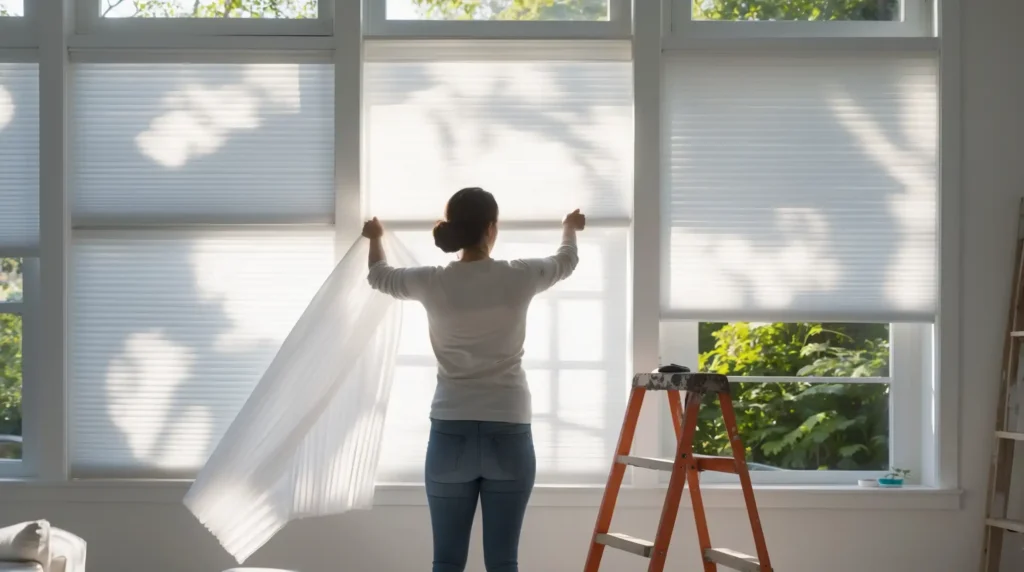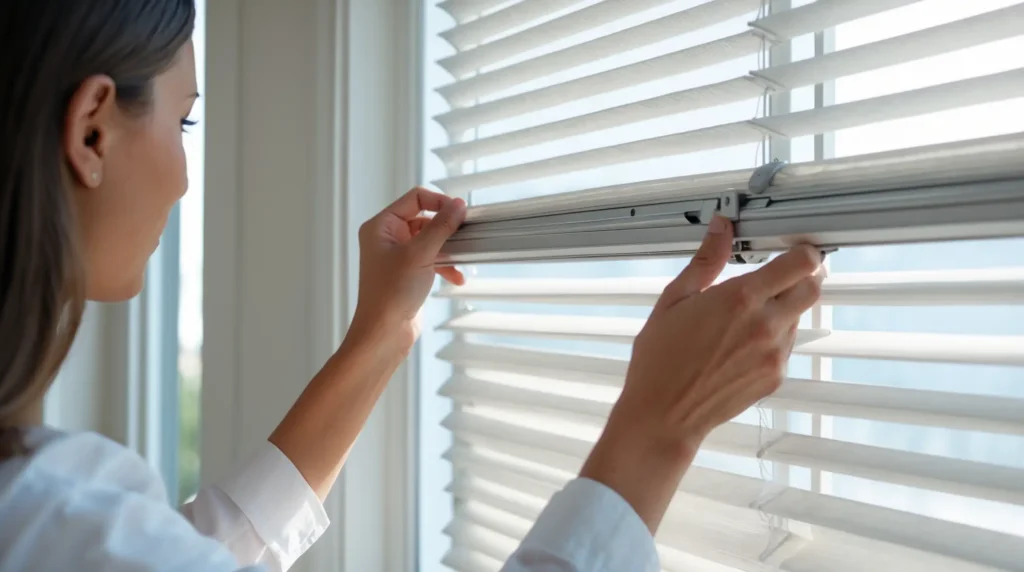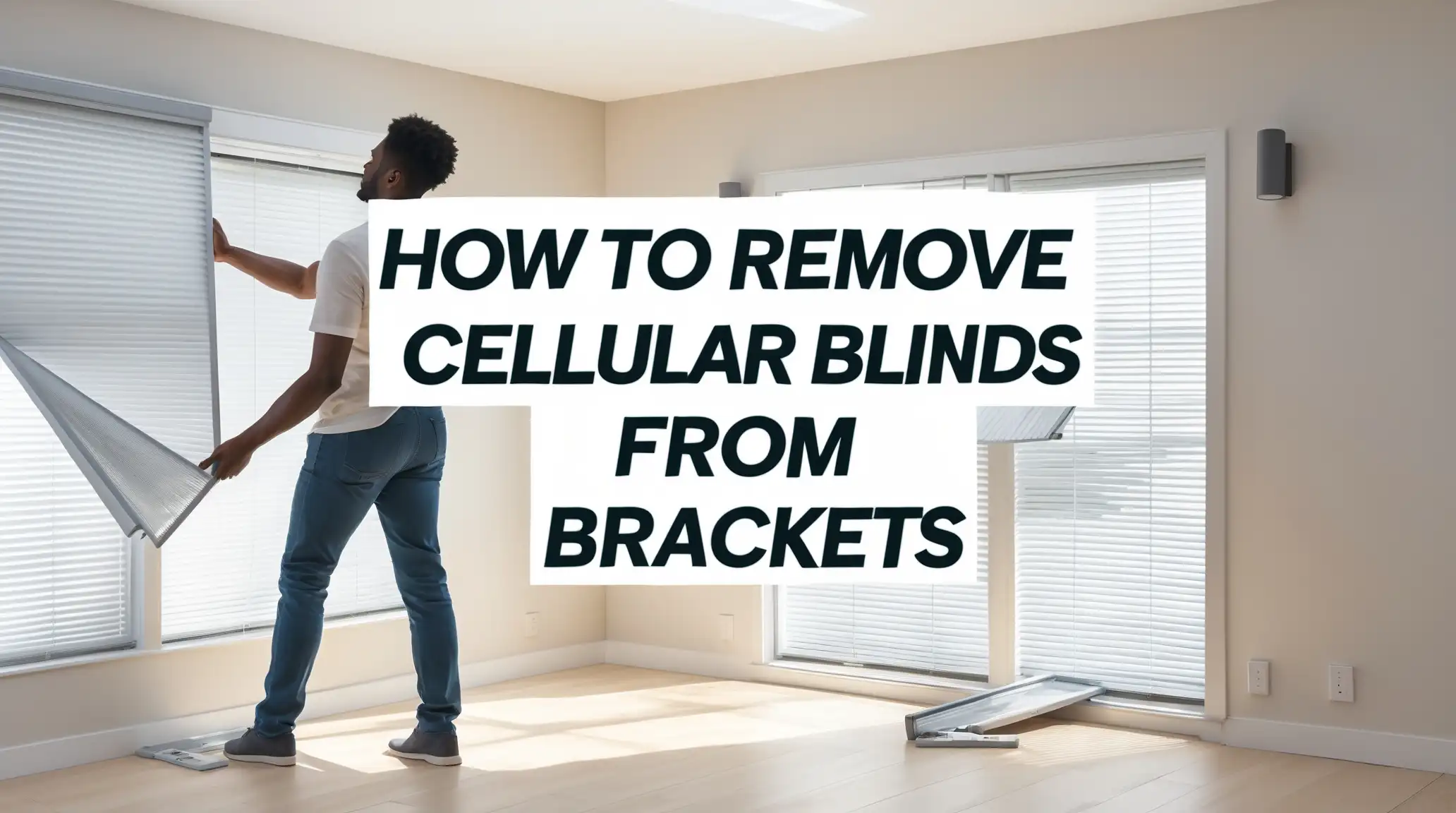Understanding Cellular Blinds and How They Work
Cellular blinds, sometimes called honeycomb shades, are a favorite in many homes for their unique look and energy-saving design. They are made from soft fabric that forms small air pockets these “cells” trap air and help regulate the room’s temperature. The shades are usually lightweight but can feel sturdy because of their layered construction.
Before you try how to remove cellular blinds from brackets, it helps to understand the parts. A typical setup includes a headrail (the top piece that holds everything together), mounting brackets (which keep the blind fixed to the window frame), and sometimes cords or cordless mechanisms. Whether you plan to clean, repair, or replace your blinds, knowing how each part works will make the removal process much easier.
Many people don’t think about the design until they try to take them down. This is when details like hidden brackets, top-down bottom-up systems, or cordless features start to matter. If you know the type of blind you have and how it connects to the brackets, you’re already halfway there.
Why You Might Need to Remove Your Blinds

Homeowners remove cellular shades for all sorts of reasons. Some simply want to give their windows a good cleaning. Dust, pollen, and even insects can collect inside the fabric folds over time. Others remove them when repainting or replacing window trim to avoid paint splatters or accidental damage.
You might also need to remove your blinds if they’re broken or worn out. Cords can fray, cordless lift systems can fail, or fabric can discolor in areas that get a lot of sun. If you’re upgrading to new shades, removing the old ones is the first step.
Seasonal maintenance is another common reason. In climates where seasons are extreme, blinds can be taken down for deep cleaning before summer or winter. Some homeowners even switch to different types of window coverings during certain times of the year for better insulation or light control.
Tools You’ll Need Before You Begin
Before you get started, gather the tools you’ll need. The good news is, you probably already have most of them at home. Here’s a basic list:
-
Flathead screwdriver – Perfect for releasing the brackets without damaging them.
-
Phillips screwdriver – If your brackets are secured with screws, this is essential.
-
Step stool or small ladder – Makes it easier to reach the headrail safely.
-
Soft cloth or towel – Protects your window frame and catches dust.
-
Work gloves – Keeps your hands clean and safe from sharp edges.
Having these tools ready before you start will make the process smoother and faster. It’s also smart to keep a small container or bag nearby to store screws or small parts you remove. That way, nothing gets lost if you plan to reinstall the blinds later.
Preparing Your Space for Blind Removal

Taking a few minutes to prepare your space can save you from scratches, dents, or accidents. Start by clearing the area around the window. Move furniture, plants, or decorative items out of the way. If your window is above a couch or table, cover it with a cloth in case dust or dirt falls during removal.
If you have blinds with hidden brackets or a top-down bottom-up system, you might need a bit more space to work. Some of these designs require tilting or sliding the headrail in a specific way, which is easier when nothing blocks your movement.
You should also open the blinds fully before removing them. This makes them lighter and easier to handle. In the case of cordless blinds, gently lift them to the top and lock them in place. For corded blinds, pull the cord until the fabric stack is as small as possible.
Step-by-Step Guide: How to Remove Cellular Blinds from Brackets
Now that you’ve prepared your space and gathered your tools, let’s go through the process.
-
Raise the blinds fully – This reduces weight and makes them easier to handle.
-
Locate the release mechanism – Most brackets have a small tab or clip that locks the headrail in place.
-
Press or lift the release tab – Using your fingers or a flathead screwdriver, gently push the tab while supporting the headrail with your other hand.
-
Tilt the headrail forward – Once released, tilt it toward you to free the front edge from the bracket.
-
Lift the headrail out – Slide the back of the headrail upward and away from the bracket.
-
Check for any extra cords or attachments – If you have special features like motorized controls, carefully disconnect them.
If you feel resistance, stop and check the brackets. Forcing the headrail out could bend the metal or crack the plastic, making future use difficult.
How to Remove Cordless Cellular Shades from Bracket
Cordless systems are popular because they’re easy to operate and safer for homes with children or pets. However, they do have slightly different removal steps.
First, make sure the shade is fully raised. This not only reduces weight but also keeps the internal spring mechanism from snapping suddenly. Locate the release levers or push buttons on the brackets. These might be at the front, side, or underneath, depending on the brand.
Hold the headrail firmly with both hands. Press the release mechanism while tilting the headrail toward you. Keep your movements steady cordless systems sometimes have more tension in the brackets, and a quick release could cause the rail to drop unexpectedly.
If your shade is stubborn, try gently wiggling it while pressing the release tab. Just avoid twisting too hard, as this could warp the rail.
How to Take Down Accordion or Pleated Blinds Safely.

Accordion blinds, also called pleated blinds, work in a similar way to cellular shades but usually have a single layer of fabric. The process for removing them is much the same.
Start by raising the blind all the way up. Check how it’s mounted some pleated blinds use the same brackets as cellular shades, while others have hooks or clips. Release the locking mechanism, then tilt the headrail forward and lift it out.
When learning how to take down accordion blinds, the most important thing is to support the rail while you work. Even though they’re light, letting one end drop could cause the fabric to crease or tear.
Removing Blinds with Hidden or Top-Down Bottom-Up Brackets
Hidden brackets are designed for a cleaner look, but they can make removal trickier. Instead of visible tabs, you may need to slide a flathead screwdriver into a small slot behind the headrail. Twist gently to release the lock, then tilt the rail forward and remove it.
Top-down bottom-up blinds require extra care. You’ll need to detach both the upper and lower cords before removing the rail. This usually involves unhooking or unclipping them from small anchors inside the brackets. Keep track of which cord goes where if you plan to reinstall the shade later.
These steps also apply if you’re figuring out how to remove blinds with hidden brackets in general. The key is patience hidden systems are secure by design, so rushing can cause damage.
Tips for Taking Down Window Shades Without Damage in Decatur, GA
In some areas, weather conditions can affect how easily blinds come down. In Decatur, GA, warm summers and humid air can cause wood frames to swell slightly, making brackets feel tighter. If this happens, loosen the screws on the brackets slightly before trying to remove the headrail.
If the brackets are painted over, carefully score the paint line with a utility knife to prevent peeling when you remove the blind. For older blinds, be prepared for dust buildup wearing gloves can keep your hands clean and protect against sharp edges.
What to Do After Removing Your Blinds
Once your blinds are down, it’s time to decide what’s next. If you’re storing them, wipe away any dust and place them in a protective bag. If you’re replacing them, now’s a great time to clean the window frame before the new installation.
For homeowners who prefer professional help, Bella Casa Shade & Drapery can assist with installing new shades, adjusting brackets, or even helping you choose a completely new style. With expert care, you can be sure your windows will always look polished and well-maintained.
If you’re ready to refresh your home with updated window treatments, reach out to Bella Casa Shade & Drapery today. Our team makes the process simple from start to finish so you can enjoy beautiful, functional blinds without the stress.
Conclusion
Removing cellular blinds from brackets doesn’t have to be a stressful task. With the right tools, a little preparation, and a clear understanding of how your blinds are installed, you can take them down safely without damage. Whether you’re cleaning, replacing, or upgrading your shades, following these steps will save time and protect your investment.
If you ever feel unsure or want a flawless result, remember that professionals can make the process quick and worry-free. The team at Bella Casa Shade & Drapery has years of hands-on experience and can handle everything from blind removal to installing beautiful new window coverings.



